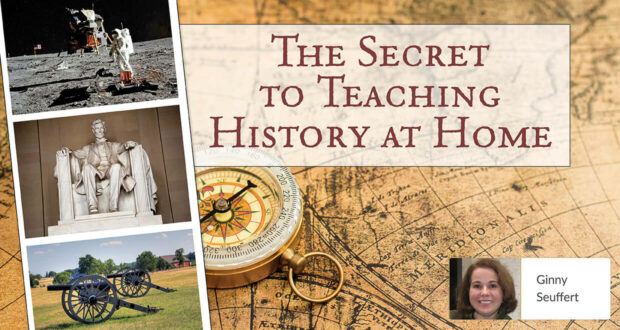Summary
Ginny Seuffert is passionate about teaching history and has tips and local resources unique to you to make the subject come alive for your family.At one point, my husband and I had three kids in college, all of whom were history majors. Everyone is out of college now, but we are still a history family with frequent kitchen table discussions. We feel we were successful in passing on our love of history. What were our secrets?
Students Need a Textbook
To answer one frequently asked question: Yes, your students do need a textbook. I prefer to think of textbooks as an imaginary file cabinet. Studying Seton’s texts, students gain basic knowledge and can put subject “folders” into their file cabinets: Voyages of Discovery, Native Peoples, Civil War, and the Great Depression to name just a few.
Your children have a mental timeline and have heard of the significant places and players. Now comes the fun part. Fill those “folders” with personalities, details, and events.
Biographies and Battles are the Way to Go
In the non-fiction section of your local public library, find reading-level-appropriate books to bring textbook chapters alive. Students are often most excited to learn about the places where they live or the circumstances of their own lives.
Growing up in New York, a child can read about the old Dutch patroon system. Massachusetts students might study Massasoit, and South Carolina kids Francis Marion, the “Swamp Fox.” A child who struggles might want to discover the extraordinary accomplishments of Helen Keller, who was both deaf and blind.
By fifteen, Andrew Jackson was an orphan with no siblings and a war veteran who lived entirely independently. With no money or family support, Jackson became a lawyer, judge, congressman, senator, general, and President of the United States.
Catholic children will be captivated to hear why this Protestant president thanked the Ursuline Sisters after winning the Battle of New Orleans. Non-fiction fills your children’s “folders” with stories and triumphs from the past.
Add Historical Fiction
As a little girl, I devoured Laura Ingalls Wilder’s Little House books. In my mind, I lived in a log cabin in Wisconsin and a sod house in Minnesota. I witnessed history reading Robert Lawson’s fun series featuring events seen through the eyes of famous figures’ pets in Ben and Me, I Discover Columbus, and Mr. Revere and I. Your students can fight an imaginary battle against tyranny with Johnny Tremain and protect their homes from the danger in Madeline Takes Command.
Parents—be cautious about movie content, but there are some excellent choices. Children can learn about space travel from Apollo 13, the Battle of Gettysburg from the movie Gettysburg, and civil rights in the 1960s from Hidden Figures.
Don’t Forget Class Trips
We spent leisure time touring battlefields, restored mansions and villages, museums, and historically significant churches. No matter where you live, you can find an old courthouse or one-room schoolhouse.
Reading about the Pilgrims simply does not carry the impact of visiting the recreated Mayflower and touring Plimoth Plantation. It is one thing to learn about Junipero Serra but quite another to visit the missions he founded up and down the coast of California.
On September 11, 2002, my family went to our local firehouse. The fire chief rang the bell and read out the names of all the firemen who perished when the Twin Towers collapsed. Participating in history, even in a small way, leaves
an impression.
Kids Need Current Events
Until my teen years, my dad worked for the Associated Press, a news service. News stories were a big part of our suppertime conversation. Not only did we hear about current events, but they were filtered through the value system of my parents and extended family. We were given points of view and sometimes debated them over plates of pasta.
When your children learn about our founding documents, discuss how these documents continue to influence our daily lives. Where do our rights as Americans come from – the government or our Creator? Should people be allowed to own firearms or is the 2nd Amendment outdated? Was there ever a constitutional right to an abortion?
Discuss the situation in the Middle East, threats from China or Russia, and the implications of a shrinking population worldwide. This will teach your children not only the impact of history on current events but also put them on a path to responsible citizenship.
Check Out Our Podcast: Stay-at-Homeschooling Mom
Are you interested in learning more about teaching history? Mary Ellen Barrett and I interviewed historian Jerry Lenaburg in Teaching History the Way It Actually Happened on July 5, 2023.
Listen to the Podcast at www.setonhome.org/podcast

 Seton Magazine Catholic Homeschool Articles, Advice & Resources
Seton Magazine Catholic Homeschool Articles, Advice & Resources
